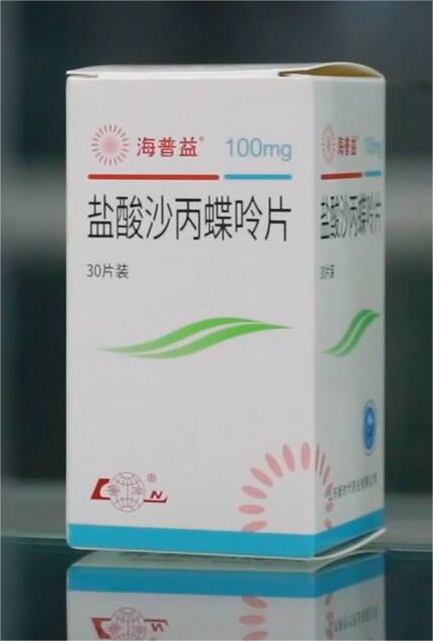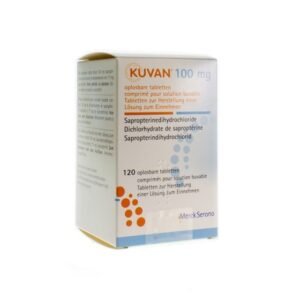Sapropterin Dihydrochloride tablets Kuvan
Functions and indications:
1. It is suitable for hyperphenylalaninemia (HPA) caused by tetrahydrobiopterin (BH4) deficiency that responds to treatment with sapropterin hydrochloride. It can be used in adults and children over 4 years old. 2. There is no sufficient clinical experience in the use of this product in children aged 0-4 years. If it must be used, it must be used with caution under the strict guidance of a specialist.
Usage and Dosage: This product must be used under the guidance of a physician with experience in the treatment of BH4 deficiency and the treatment process must be supervised. A single dose of this product should be taken with meals, at the same time every day, preferably in the morning. During the use of this product, it is necessary to actively control the intake of phenylalanine and total protein in the diet to ensure effective control of blood phenylalanine concentration and nutritional balance. HPA caused by BH4 deficiency is a chronic disease. Once it is confirmed to respond to treatment with this product, long-term use should be planned, but there is currently limited data on long-term use of this product. 1. Dosage: This product is a 100mg tablet. Calculate the daily dose based on body weight and round it to a multiple of 100. For example, a calculated dose of 401mg to 450mg should be rounded to 400mg, equivalent to 4 tablets. A calculated dose of 451-499mg should be rounded to 500mg, equivalent to 5 tablets. When the dose is less than 100mg, 1 tablet should be dissolved in 100mL of water, and then an equivalent volume of solution should be taken according to the dose prescribed by the doctor. An accurate device with appropriate scales should be used to measure the solution to ensure that the volume of the solution matches the prescribed amount. The starting dose for adults and children with BH4 deficiency is 2-5mg/kg body weight once a day. The dose can be adjusted to 20mg/kg/day. The total daily dose can also be divided into 2 or 3 doses per day as needed to optimize the therapeutic effect. 2. Response determination: The most important thing is to start treatment with this product as soon as possible to avoid irreversible clinical manifestations of neurological diseases in children and cognitive dysfunction and psychiatric diseases in adults due to continued increase in blood phenylalanine. The response to treatment with this product can be determined based on the decrease in phenylalanine in the blood. Blood phenylalanine concentrations should be measured before starting treatment with this product and after 1 week of treatment at the recommended starting dose. If an unsatisfactory decrease in blood phenylalanine concentration is observed, the dose of this product can be increased weekly to a maximum dose of 20 mg/kg/day, and blood phenylalanine concentrations should continue to be monitored weekly for 1 month. During this period, dietary intake of phenylalanine should be maintained at a constant level. A good response is defined as a decrease in blood phenylalanine concentration of >30%, or reaching the therapeutic blood phenylalanine target value determined by the attending physician based on the individual patient’s situation. If the patient still cannot meet the above standards after 1 month of treatment, it should be considered ineffective and should not continue to receive this product. Once a response to treatment with this product is confirmed, the dose can be adjusted within the range of 5-20 mg/kg/day based on the therapeutic effect. It is recommended to test blood phenylalanine and tyrosine concentrations 1-2 weeks after each dose adjustment and to monitor frequently thereafter. Patients treated with this product must continue to adopt a diet that restricts phenylalanine intake and undergo regular clinical assessments (such as monitoring blood phenylalanine and tyrosine concentrations, nutrient intake, and psychomotor development). 3. Dosage: The single daily dose of this product should be taken with meals to promote absorption; take it at the same time every day, preferably in the morning. Patients should be instructed not to swallow the dehumidifying capsules in the medicine bottle. The prescribed number of tablets of this product should be placed in a cup of water and stirred until the tablets are dissolved. Dissolution may take several minutes. Crushing the tablets can speed up the dissolution rate. Small particles may be seen in the solution, but this will not affect the efficacy of this product. The liquid medicine should be drunk within 15-20 minutes after dissolution. Adults: The prescribed number of tablets of this product should be placed in a cup with 120-240mL of water, stirred until the tablets are dissolved and then taken. Children: The prescribed number of tablets of this product should be placed in a cup with 120mL of water, stirred until the tablets are dissolved and then taken. Treatment with this product can only be stopped under the guidance of a physician. Blood phenylalanine concentrations may increase after discontinuation of medication, so more frequent monitoring is required. Diet adjustment is required to keep blood phenylalanine concentrations within the ideal therapeutic range.
Adverse reactions:
1. Clinical trials showed that approximately 35% of 579 patients treated with sapropterin hydrochloride (5-20 mg/kg/day) experienced adverse reactions. The most commonly reported adverse reactions were headache and runny nose. The following adverse reactions have been identified in the main clinical trials of this product. Definition of the frequency of adverse drug reactions: very common (≥1/10) and common (≥1/100-<1/10). In each frequency grouping, the adverse reactions are arranged in descending order according to their severity. (1) Nervous system diseases: headache is very common. (2) Respiratory system, chest and mediastinal diseases: runny nose is very common; sore throat, nasal congestion, cough are common. (3) Gastrointestinal diseases: diarrhea, vomiting, abdominal pain are common. (4) Metabolic and nutritional diseases: hypophenylalaninemia is common. 2. Safety experience in clinical trials for non-phenylketonuria (PKU): In 19 controlled and uncontrolled clinical trials, approximately 800 healthy volunteers and non-PKU patients, some of whom had underlying neurological abnormalities or cardiovascular disease, received drugs with the same active ingredient (sapropterin) but different dosage forms. In these clinical trials, the subjects were given sapropterin at a dose range of 1-20 mg/kg/day, and the duration of administration ranged from 1 day to 2 years. Serious and severe adverse events (whether related or not) that occurred during sapropterin administration were convulsions, aggravated convulsions, dizziness, gastrointestinal bleeding, postoperative bleeding, headache, irritability, myocardial infarction, overstimulation, and respiratory failure. Common adverse reactions were headache, peripheral edema, joint pain, polyuria, agitation, dizziness, and upper respiratory tract infection. 3. Post-marketing experience: In a 10-year post-marketing safety monitoring study of another dosage form of the same active ingredient (sapropterin) conducted in Japan, the following adverse reactions were observed. The safety monitoring study was conducted in 30 patients, 27 of whom had other diseases in addition to PKU and potential neurological symptoms. The most common adverse reactions were convulsions and exacerbations in 3 non-PKU patients and increased gamma-glutamyl transferase (GGT) in 2 non-PKU patients. Rebound may occur when treatment is stopped, that is, the blood phenylalanine concentration increases above the pre-treatment concentration.
Contraindications:
Patients with known allergies to the active ingredients or any excipients of this product are contraindicated.
Share:
Products
Our offers
Health Classification
Let us work together to protect precious health


































